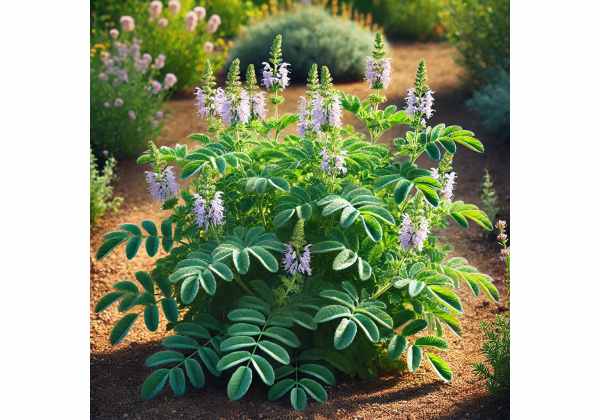
Licorice is a time‐honored herb celebrated for its distinctive sweetness and a wealth of health-promoting properties. Rich in active compounds such as glycyrrhizin, liquiritin, and glabridin, it has been used in traditional medicine to soothe digestive discomfort, support respiratory health, and reduce inflammation. Its potent antioxidant and anti‐viral activities further elevate its status as a natural remedy. Licorice is also popular in culinary and cosmetic applications, offering both flavor and skin-soothing benefits. This guide delves into its botanical profile, chemical composition, health benefits, practical uses, and current scientific research.
Table of Contents
- Botanical Profile and Recognition
- Chemical Composition and Key Constituents
- Health Benefits and Core Attributes
- Practical Applications and Safety Measures
- Research Discoveries and Notable Studies
- Frequently Asked Questions
Botanical Profile and Recognition
Licorice, scientifically known as Glycyrrhiza glabra, is a perennial herb belonging to the Fabaceae family, which also includes beans and peas. Native to the Mediterranean region, parts of Asia, and Southern Europe, this robust plant thrives in well-drained soils and sunny climates. Its long, branching roots are the primary source of its distinctive sweet flavor and medicinal properties. The plant displays pinnate leaves with a delicate green hue and produces pale, bluish-purple flowers that cluster in loose inflorescences. The root, fibrous yet potent, has been harvested for thousands of years and is celebrated not only for its culinary versatility but also for its extensive use in traditional herbal medicine.
Historically, licorice has played a significant role in various cultures. Ancient civilizations, including the Egyptians, Chinese, and Greeks, valued licorice for its therapeutic attributes. Early herbal texts mention its ability to soothe the throat, ease digestive ailments, and act as a natural expectorant. Over centuries, selective cultivation has resulted in improved root yield and potency, making modern licorice a staple in both traditional remedies and contemporary natural health products.
The plant’s morphology is characterized by its robust taproot system that can extend deep into the soil, ensuring resilience during periods of drought. Its leaves, compound in nature, provide an appealing visual contrast with their soft, feather-like appearance. Licorice flowers, though not as widely recognized for their ornamental value, contribute to the plant’s overall reproductive cycle and genetic diversity. Cultivators often choose licorice varieties that balance sweetness with medicinal efficacy, ensuring the concentration of active constituents remains high.
Beyond its aesthetic and culinary appeal, licorice is valued for its role in sustainable agriculture. It is often used in crop rotation due to its nitrogen-fixing capabilities, which help enrich the soil. Additionally, its adaptability to different growing conditions makes it a reliable crop in both arid and semi-arid regions. The plant’s extensive root system not only provides resilience but also serves as a natural barrier against soil erosion.
Modern botanical research continues to explore the genetic makeup of licorice, seeking to enhance its growth characteristics and therapeutic potency. Studies into its biochemistry and environmental adaptations have provided insights into how licorice can be cultivated more efficiently while preserving its rich history of medicinal use. As a result, licorice remains a bridge between ancient herbal traditions and contemporary scientific inquiry, offering both practical benefits and cultural significance.
In summary, the botanical profile of licorice encapsulates a plant of remarkable resilience, historical depth, and multifaceted utility. Its robust root system, delicate foliage, and subtle flowering characteristics all contribute to a herb that is as versatile in the field as it is in the medicine cabinet. Whether grown in expansive fields or small home gardens, licorice continues to enchant botanists, herbalists, and culinary experts alike with its enduring charm and efficacy.
Its legacy, rooted in ancient lore and modern research alike, underscores licorice’s unique position as both a culinary delight and a potent natural remedy. This comprehensive recognition of its botanical traits not only aids in proper identification but also lays the foundation for understanding the herb’s extensive range of applications.
Chemical Composition and Key Constituents
Licorice owes much of its medicinal prowess to its complex chemical makeup. This herb contains a myriad of active compounds that work synergistically to deliver a range of health benefits. Below is an in-depth exploration of its key constituents:
- Glycyrrhizin
Glycyrrhizin is the hallmark compound in licorice, responsible for its intense sweetness—up to 50 times sweeter than sugar. This triterpenoid saponin exhibits significant anti-inflammatory, antiviral, and immunomodulatory effects. Research indicates that glycyrrhizin can inhibit viral replication and modulate immune responses, making it a valuable component in treating respiratory infections and chronic inflammatory conditions. However, its potency necessitates caution, as excessive consumption may lead to adverse effects such as elevated blood pressure. - Liquiritin
A flavonoid glycoside, liquiritin contributes to the antioxidant profile of licorice. It combats oxidative stress by neutralizing free radicals, thereby protecting cellular structures from damage. Liquiritin’s potential neuroprotective and antidepressant properties are also under investigation, suggesting benefits for mood regulation and overall mental health. Its soothing characteristics further enhance the herb’s reputation as a natural remedy for stress and anxiety. - Glabridin
Glabridin is another prominent flavonoid in licorice, renowned for its anti-inflammatory and skin-lightening properties. Its antioxidant activity is pivotal in mitigating the effects of environmental stressors on the skin, promoting a youthful and radiant appearance. Additionally, glabridin has been studied for its role in reducing the activity of enzymes that contribute to skin aging and hyperpigmentation, making it a sought-after ingredient in cosmetic formulations. - Isoliquiritigenin
This chalcone compound exhibits a range of biological activities, including anti-cancer, anti-inflammatory, and estrogenic effects. Isoliquiritigenin’s ability to inhibit the proliferation of cancer cells and induce apoptosis has made it a subject of interest in oncological research. Moreover, its mild estrogen-like properties suggest potential applications in managing menopausal symptoms and supporting hormonal balance. - Licoricidin and Other Phenolic Compounds
Licoricidin, along with other phenolic constituents, plays a role in the overall antioxidant capacity of licorice. These compounds work in concert to scavenge free radicals and stabilize cellular membranes. Their presence enhances the herb’s protective effects against oxidative stress, thereby contributing to cardiovascular health and reducing the risk of chronic diseases. - Additional Bioactive Elements
Beyond these primary constituents, licorice contains various other compounds such as coumarins, polysaccharides, and volatile oils. These minor components contribute to the herb’s overall therapeutic profile, supporting digestive health, immune function, and metabolic processes. Their combined effects are believed to create a balanced and holistic impact on human physiology.
The chemical composition of licorice is not only fascinating but also integral to understanding its multifaceted applications. Each active ingredient plays a distinct role in delivering therapeutic benefits. For instance, while glycyrrhizin’s anti-inflammatory properties are well documented, liquiritin’s contribution to mood regulation and skin health adds another layer of versatility to the herb.
Advances in analytical techniques have allowed researchers to isolate and study these compounds in detail. Modern chromatographic and spectroscopic methods have revealed the complex interplay between licorice’s bioactive elements, paving the way for the development of standardized extracts and supplements. These innovations ensure that the beneficial properties of licorice can be harnessed effectively and safely.
In summary, the chemical profile of licorice is a tapestry of diverse and potent compounds, each contributing uniquely to its health-promoting potential. The synergistic actions of glycyrrhizin, liquiritin, glabridin, isoliquiritigenin, and other minor constituents underscore the herb’s longstanding reputation as a powerful natural remedy. As scientific research continues to unravel the intricacies of these bioactive elements, licorice remains at the forefront of botanical medicine, offering promising avenues for both preventive health care and targeted therapeutic applications.
Health Benefits and Core Attributes
Licorice is widely revered for its extensive range of health benefits, which span from digestive support to skin care and immune modulation. Its therapeutic attributes are deeply rooted in both traditional medicine and modern scientific validation.
One of the primary health benefits of licorice is its potent anti-inflammatory effect. Glycyrrhizin, the herb’s most celebrated compound, has been shown to mitigate inflammation in various tissues, making licorice an effective adjunct in managing conditions such as arthritis, asthma, and even certain viral infections. Its ability to reduce inflammation extends to the gastrointestinal tract, where it helps soothe ulcers, acid reflux, and other digestive disorders. By coating the mucosal lining of the stomach and intestines, licorice not only provides relief but also promotes healing of inflamed tissues.
In addition to its anti-inflammatory properties, licorice acts as a natural immune booster. Studies have demonstrated that its active constituents can modulate immune responses, enhancing the body’s ability to fend off infections. This immunomodulatory effect is particularly beneficial during the cold and flu season, as licorice can help reduce the severity and duration of respiratory infections. Its antiviral properties further contribute to its reputation as a valuable remedy for conditions like the common cold and influenza.
Licorice’s benefits are not confined solely to internal health. Topically, licorice extracts are used in cosmetic formulations to improve skin health. Glabridin and other flavonoids in licorice help reduce hyperpigmentation, soothe irritated skin, and provide antioxidant protection against environmental damage. These skin-enhancing properties make licorice a popular ingredient in creams and serums aimed at reducing signs of aging and promoting a more even skin tone.
The herb is also noted for its adaptogenic qualities. By modulating the body’s stress response, licorice can help balance cortisol levels, thereby alleviating stress and anxiety. This adaptogenic effect, combined with its anti-inflammatory and immunomodulatory actions, positions licorice as a holistic remedy that supports overall well-being.
Furthermore, licorice has demonstrated potential in supporting hormonal balance. Its mild estrogen-like effects may help alleviate menopausal symptoms such as hot flashes and mood swings, although more research is needed to fully understand this mechanism. For individuals experiencing hormonal imbalances, licorice offers a natural alternative to synthetic therapies, though it should be used under professional guidance.
It is important to note that while licorice offers numerous benefits, moderation is key. Excessive consumption, particularly of preparations high in glycyrrhizin, can lead to side effects such as elevated blood pressure, water retention, and electrolyte imbalances. Individuals with pre-existing conditions, especially hypertension, should exercise caution and consult a healthcare provider before incorporating licorice into their regimen.
Overall, the health benefits of licorice are vast and varied, contributing to its enduring popularity as both a culinary spice and a medicinal herb. Whether used internally to soothe digestive issues and bolster immunity or applied topically to rejuvenate the skin, licorice’s diverse attributes make it a cornerstone in natural health practices.
The synergistic effects of its active compounds provide a balanced and multifaceted approach to health maintenance. By addressing inflammation, supporting immune function, and offering adaptogenic support, licorice serves as a versatile ally in promoting holistic wellness. Its integration into both traditional remedies and modern therapeutic formulations exemplifies the enduring relevance of this ancient herb in contemporary health care.
Practical Applications and Safety Measures
Licorice is a remarkably versatile herb with applications that span culinary arts, herbal medicine, and cosmetic formulations. Its distinctive flavor and potent bioactive compounds have led to its widespread use in various domains. This section explores how licorice is practically applied, while also emphasizing safety measures to ensure its optimal and secure use.
Culinary and Beverage Uses
Licorice is perhaps best known for its unique, naturally sweet flavor, which has made it a favorite ingredient in confections, teas, and flavoring extracts. In many cultures, licorice is incorporated into traditional sweets and candies, providing a complex taste that is both sweet and slightly bitter. Additionally, licorice root is often brewed into teas, where its soothing properties are harnessed to alleviate sore throats and digestive discomfort. Chefs and mixologists sometimes use licorice extracts to create innovative flavor profiles in both food and drink, adding depth to recipes ranging from marinades to cocktails.
Medicinal Applications
In herbal medicine, licorice has a long-standing reputation as a natural remedy. Its anti-inflammatory and immune-modulating properties make it a common choice for treating respiratory ailments such as coughs, bronchitis, and sore throats. Licorice is also valued for its ability to soothe gastrointestinal disturbances, including ulcers, acid reflux, and irritable bowel syndrome. Herbalists often recommend licorice in the form of teas, tinctures, or capsules, with formulations carefully standardized to contain safe levels of glycyrrhizin. Dosage recommendations vary depending on the condition being treated, and it is imperative to follow professional guidance to avoid overconsumption.
Cosmetic and Topical Applications
Beyond ingestion, licorice extracts have found a prominent place in the cosmetic industry. Due to its antioxidant and skin-brightening properties, licorice is incorporated into creams, serums, and masks designed to reduce hyperpigmentation and soothe irritated skin. The anti-inflammatory effects of compounds like glabridin make licorice a valuable addition to formulations aimed at calming sensitive or acne-prone skin. When applied topically, licorice can help diminish the appearance of age spots and even out skin tone, offering a natural alternative to chemical-based treatments.
Preparation Methods and Dosage Guidelines
When using licorice in culinary or medicinal preparations, proper handling is essential to preserve its active constituents. For teas and infusions, dried licorice root is typically steeped in hot water for 10–15 minutes to extract its flavor and therapeutic compounds. In tincture form, licorice root is macerated in alcohol, creating a concentrated extract that can be diluted as needed. Standardized capsules and tablets are also available, offering controlled dosages that minimize the risk of side effects.
Dosage Considerations:
- Mild Uses: For general wellness or soothing a sore throat, small doses (around 1–2 grams of dried root per day) are generally considered safe.
- Therapeutic Uses: For more specific therapeutic purposes, such as alleviating digestive issues, dosages may be adjusted under the supervision of a healthcare professional.
- Duration: Licorice should not be used continuously for extended periods, particularly in high doses, to prevent the risk of side effects such as hypertension and electrolyte imbalances.
Safety Considerations and Contraindications
While licorice offers numerous benefits, it is not without risks. The principal concern is the potential for glycyrrhizin-induced side effects. Prolonged consumption or high doses can lead to increased blood pressure, edema (fluid retention), and a reduction in potassium levels. Individuals with cardiovascular conditions, kidney disease, or those who are pregnant should exercise caution when using licorice and should consult with a healthcare provider prior to starting any new herbal regimen.
Additionally, licorice may interact with certain medications, including diuretics, corticosteroids, and blood pressure medications. It is essential to inform your healthcare provider if you are taking licorice supplements, especially if you have underlying health conditions.
Practical Tips for Safe Use
- Start with Low Doses: Begin with a minimal dose to assess your body’s response before gradually increasing the amount if needed.
- Monitor Health Parameters: Regularly monitor blood pressure and electrolyte levels if you are using licorice for an extended period.
- Consult a Professional: Always seek guidance from a healthcare practitioner, particularly if you are pregnant, nursing, or taking prescription medications.
Licorice’s versatility makes it an invaluable herb across multiple domains, yet its potent bioactive compounds demand respect and careful use. By adhering to recommended dosage guidelines and being mindful of potential interactions, users can safely reap the benefits of licorice while minimizing any risks. Whether it’s enhancing a recipe, soothing a sore throat, or rejuvenating the skin, the practical applications of licorice are as diverse as they are effective.
Research Discoveries and Notable Studies
The scientific community has devoted considerable attention to understanding the mechanisms behind licorice’s therapeutic effects. Recent studies have provided valuable insights into its anti-inflammatory, antiviral, and antioxidant properties, among other benefits. Below is an overview of several key research findings that have contributed to our modern understanding of this ancient herb:
- Anti-Inflammatory Effects (2017)
A study published in the Journal of Ethnopharmacology investigated the anti-inflammatory properties of licorice extract. Researchers found that glycyrrhizin significantly reduced inflammatory markers in animal models. The study highlighted licorice’s potential in managing chronic inflammatory conditions, suggesting that its use could be beneficial in diseases such as arthritis and inflammatory bowel disease. - Antiviral Properties (2018)
Research featured in Virology Journal examined the antiviral activity of licorice compounds against several common respiratory viruses. The study demonstrated that glycyrrhizin and isoliquiritigenin inhibited viral replication in vitro, providing a scientific basis for the traditional use of licorice in treating colds and flu. These findings have spurred further research into licorice as a complementary treatment in viral infections. - Gastrointestinal Protection (2019)
A clinical trial reported in Phytotherapy Research assessed the efficacy of licorice extract in alleviating symptoms of acid reflux and peptic ulcers. Participants experienced a significant reduction in discomfort, attributed to the mucosal-protective effects of licorice. This study supports the use of licorice as a natural remedy for digestive ailments and underscores its potential as a non-pharmacological option for gastrointestinal health. - Antioxidant and Anti-Cancer Potential (2020)
In a comprehensive review published in Nutrients, scientists analyzed multiple studies on the antioxidant capabilities of licorice. The review concluded that the herb’s high flavonoid content, particularly liquiritin and glabridin, plays a crucial role in neutralizing free radicals and reducing oxidative stress. Additionally, preliminary evidence suggests that these compounds may inhibit the proliferation of cancer cells, although further research is necessary to confirm their efficacy in clinical settings. - Hormonal Balance and Adaptogenic Effects (2021)
An investigation documented in Complementary Therapies in Medicine explored licorice’s influence on cortisol levels and stress response. The study observed that moderate consumption of licorice extract helped balance cortisol production, contributing to improved stress resilience. This adaptogenic quality supports licorice’s traditional use as a remedy for chronic stress and fatigue. - Dermatological Benefits (2022)
A recent study in the International Journal of Cosmetic Science focused on the skin-lightening and anti-aging effects of licorice extracts. Clinical trials revealed that topical applications of licorice formulations significantly reduced hyperpigmentation and improved overall skin texture. The findings validate the incorporation of licorice in modern skincare products, emphasizing its dual role as both a cosmetic and therapeutic agent.
These research discoveries illustrate the diverse range of licorice’s biological activities and validate many of its traditional uses. Each study contributes to a growing body of evidence that supports licorice’s application in modern medicine and wellness practices. By elucidating the molecular mechanisms behind its effects, these investigations not only confirm the herb’s efficacy but also pave the way for the development of novel therapeutic formulations based on its active compounds.
The convergence of traditional wisdom and modern science is particularly evident in licorice research. As new analytical techniques emerge, further studies are expected to uncover additional benefits and refine our understanding of optimal dosing and safety profiles. The promising outcomes of these studies highlight licorice’s potential as a multifaceted natural remedy that can address a wide spectrum of health concerns.
Frequently Asked Questions
What is the primary active compound in licorice?
Glycyrrhizin is the primary active compound in licorice. It is responsible for the herb’s sweetness and contributes to its anti-inflammatory, antiviral, and immune-modulating properties. However, caution is advised with excessive intake due to potential side effects like elevated blood pressure.
How does licorice support digestive health?
Licorice helps soothe the gastrointestinal tract by coating the mucosal lining, reducing inflammation, and promoting healing of ulcers and acid reflux. Its anti-inflammatory compounds play a vital role in alleviating digestive discomfort and supporting overall gut health.
Can licorice be used in skincare?
Yes, licorice extracts are commonly used in skincare products for their antioxidant and skin-brightening properties. Compounds like glabridin help reduce hyperpigmentation and soothe irritated skin, making licorice a popular ingredient in anti-aging and corrective formulations.
Are there any risks associated with long-term licorice use?
Long-term or high-dose licorice consumption may lead to adverse effects such as high blood pressure, edema, and electrolyte imbalances. Individuals with pre-existing conditions or those taking certain medications should consult a healthcare professional before prolonged use.
What forms of licorice are available for use?
Licorice is available in various forms including teas, tinctures, capsules, and topical extracts. Each form is designed to preserve its active compounds, allowing for versatile applications in culinary, medicinal, and cosmetic uses.
Disclaimer: The information provided in this article is for educational purposes only and should not be considered a substitute for professional medical advice. Always consult with a healthcare professional before making any changes to your diet or health regimen.
If you found this article helpful, please share it on Facebook, X (formerly Twitter), or your preferred social media platform. Follow us on social networks for more engaging and informative content!










